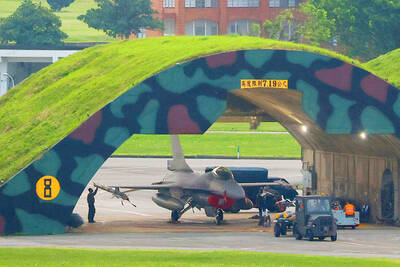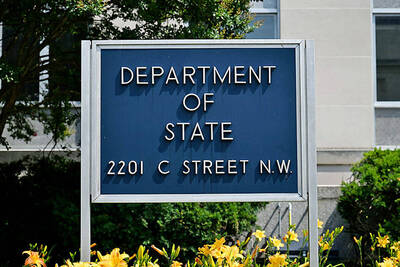The US will build new long-range weapons in a hedge against potential rivals like China, the major power best-placed to challenge US supremacy, the Pentagon said in a new strategic blueprint on Friday.
The plan would also boost US special forces by 15 percent to fight terrorism, create a military task force to thwart transfers of chemical, biological and nuclear weapons and expand psychological warfare capabilities.
The Pentagon released the congressionally mandated Quadrennial Defense Review to outline its strategy for meeting anticipated security threats in the next 20 years.
It said the choices of "major and emerging powers," including India, Russia and China, would be key to the 21st century's international security environment.
"Of the major and emerging powers, China has the greatest potential to compete militarily with the United States and field disruptive military technologies that could over time offset traditional US military advantages," the document said.
PRC CAPABILITIES
The report said China is likely to continue large investment in high-end, asymmetric military capabilities, emphasizing both electronic and cyber-warfare; counter-space operations; ballistic and cruise missiles; advanced integrated air defense systems; next-generation torpedoes; advanced submarines; strategic nuclear strike capabilities from modern, sophisticated land and sea-based systems; and theater unmanned aerial vehicles for employment by the Chinese military and for global export.
"The pace and scope of China's military build-up already puts [sic] regional military balances at risk," the report said.
It said the US would seek to encourage China to choose a path of peaceful economic growth and political liberalization, rather than military threat and intimidation.
But the US would defeat aggression if deterrence failed, the report said.
'GREAT DISTANCES'
Referring to China's large territory and a lack of US bases in the area, the Pentagon said it places a premium on "forces capable of sustained operations at great distances."
The blueprint, unveiled before tomorrow's delivery to Congress of a 2007 defense budget request of US$439.3 billion, recommended a new long-range strike capability to be fielded by 2018 and modernizing the current bomber force.
The capability could include manned or unmanned bombers as well as directed-energy weapons such as lasers. The Air Force Air Combat Command began a yearlong analysis of options for such a capability in October.
The plan called for increasing the number of aircraft carriers in the Pacific to five or six and maintaining 60 percent of Navy submarines there, while doubling to two the number of attack submarines bought annually by 2012.

MISINFORMATION: The generated content tends to adopt China’s official stance, such as ‘Taiwan is currently governed by the Chinese central government,’ the NSB said Five China-developed artificial intelligence (AI) language models exhibit cybersecurity risks and content biases, an inspection conducted by the National Security Bureau (NSB) showed. The five AI tools are: DeepSeek, Doubao (豆包), Yiyan (文心一言), Tongyi (通義千問) and Yuanbao (騰訊元寶), the bureau said, advising people to remain vigilant to protect personal data privacy and corporate business secrets. The NSB said it, in accordance with the National Intelligence Services Act (國家情報工作法), has reviewed international cybersecurity reports and intelligence, and coordinated with the Ministry of Justice Investigation Bureau and the National Police Agency’s Criminal Investigation Bureau to conduct an inspection of China-made AI language

BOOST IN CONFIDENCE: The sale sends a clear message of support for Taiwan and dispels rumors that US President Donald Trump ‘sold out’ the nation, an expert said The US government on Thursday announced a possible sale to Taiwan of fighter jet parts, which was estimated to cost about US$330 million, in a move that an expert said “sends a clear message of support for Taiwan” amid fears that Washington might be wavering in its attitude toward Taipei. It was the first announcement of an arms sale to Taiwan since US President Donald Trump returned to the White House earlier this year. The proposed package includes non-standard components, spare and repair parts, consumables and accessories, as well repair and return support for the F-16, C-130 and Indigenous Defense Fighter aircraft,

CHECKING BOUNDARIES: China wants to disrupt solidarity among democracies and test their red lines, but it is instead pushing nations to become more united, an expert said The US Department of State on Friday expressed deep concern over a Chinese public security agency’s investigation into Legislator Puma Shen (沈伯洋) for “secession.” “China’s actions threaten free speech and erode norms that have underpinned the cross-strait ‘status quo’ for decades,” a US Department of State spokesperson said. The Chongqing Municipal Public Security Bureau late last month listed Shen as “wanted” and launched an investigation into alleged “secession-related” criminal activities, including his founding of the Kuma Academy, a civil defense organization that prepares people for an invasion by China. The spokesperson said that the US was “deeply concerned” about the bureau investigating Shen

LIMITS: While China increases military pressure on Taiwan and expands its use of cognitive warfare, it is unwilling to target tech supply chains, the report said US and Taiwan military officials have warned that the Chinese People’s Liberation Army (PLA) could implement a blockade within “a matter of hours” and need only “minimal conversion time” prior to an attack on Taiwan, a report released on Tuesday by the US Senate’s China Economic and Security Review Commission said. “While there is no indication that China is planning an imminent attack, the United States and its allies and partners can no longer assume that a Taiwan contingency is a distant possibility for which they would have ample time to prepare,” it said. The commission made the comments in its annual